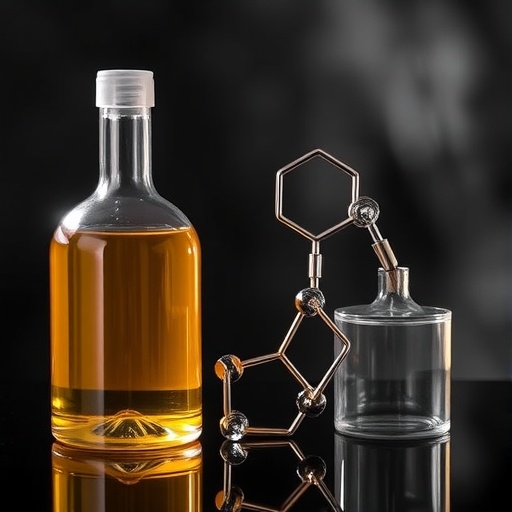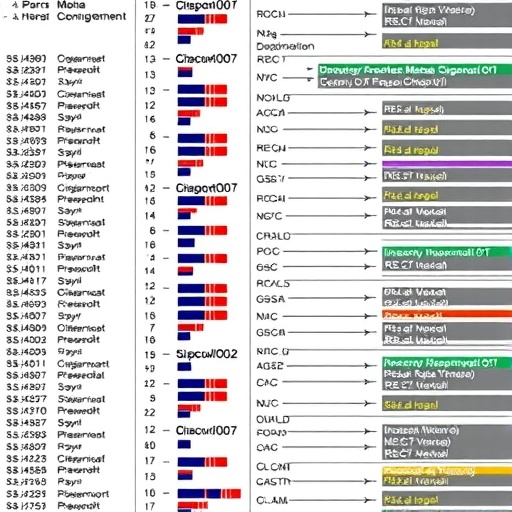In the ever-evolving landscape of organic chemistry, the quest for efficient synthesis methods has always been paramount. A recent study undertakes this challenge by introducing a novel approach for the production of benzylic-alkylated arenes, employing a bis(N-heterocyclic carbene) manganese(I) catalyst to facilitate the alkylation of arenes with alcohols. This significant advancement not only paves the way for more sustainable synthetic pathways but also brings forth potential applications in various fields, including pharmaceuticals and materials science.
The research, conducted by an esteemed team led by Luo, Zhang, and Bai, showcased the potential of leveraging manganese(I) complexes in catalysis, highlighting their role in promoting C–C bond formation. Manganese, a first-row transition metal, stands out for its unique electronic properties that can facilitate numerous chemical transformations. In this context, the authors detail how the integration of bis(N-heterocyclic carbenes) significantly enhances the catalyst’s performance, thus surpassing traditional metal catalysts.
One of the study’s primary revelations is the effectiveness of alcohols as alkylating agents. Traditionally, the field has primarily relied on halides, which can introduce environmental concerns and wasteful byproducts. By shifting the paradigm towards utilizing alcohols, the researchers present an eco-friendlier alternative that simultaneously demonstrates high reactivity and selectivity. This inventive approach mitigates the challenges associated with halide-based methods, reflecting a broader trend within the scientific community towards greener chemical practices.
Delving deeper into the experimental process, the researchers conducted a series of well-designed experiments that meticulously explored the reaction conditions. They optimized parameters such as temperature, solvent choice, and catalyst loading to find the ideal scenario for the benzylic-alkylation reaction. The fine-tuning of these variables resulted in impressive yields of target products, indicating the reliability and robustness of the manganese(I) catalyzed system. The systematic investigation serves as a testament to the diligence and precision of the research effort.
The mechanism underlying this catalyst’s activity is another aspect that merits attention. By employing advanced mechanistic studies, the authors were able to elucidate the steps involved in the catalytic cycle. It appears that the bis(N-heterocyclic carbene) ligands play a crucial role in stabilizing the metal center while also facilitating the coordination of substrates. This interaction is pivotal, as it directly influences the selectivity and efficiency of the reaction. The study provides clear evidence that understanding the mechanistic intricacies can lead to better catalyst design in the future.
The researchers also highlight the substrate scope of their method, demonstrating its versatility by applying it to various arenes. The results showed that a range of substituted benzenes could undergo successful alkylation, thus expanding the potential repertoire of compounds that could be synthesized through this innovative route. This wide applicability suggests that the described methodology could become a standard approach in synthetic laboratories around the world.
In addition to synthesizing complex chemical entities, the implications of this study extend beyond the laboratory. With the increasing demand for efficient chemical processes in both industrial and academic settings, methods that are both effective and environmentally benign are becoming more critical. The approach outlined in this research not only meets these criteria but also encourages further exploration of manganese-based catalysis, potentially leading to breakthroughs in other areas of organic synthesis.
Furthermore, the findings presented by Luo and colleagues resonate with the ongoing discussions regarding sustainability in chemical manufacturing. As the global community faces mounting pressures to reduce waste and carbon footprints, adapting existing synthetic methodologies to be more eco-friendly is essential. By championing alcohols as a preferable starting material, this research aligns perfectly with contemporary goals for sustainable chemistry.
Among the noteworthy aspects of the study is the pioneering relationship between bis(N-heterocyclic carbenes) and transition metals. The integration of these two components has opened up new avenues for research and exploration in catalysis, prompting chemists to rethink their approach to catalyst design. The insights gained from this work could inspire further investigations into other metal-catalyzed processes, contributing to the development of a more comprehensive understanding of catalytic systems.
Moreover, the accessibility of the materials and reagents employed in the study is worth mentioning. By using readily available components, the methodology not only demonstrates practicality but also shows promise for widespread adoption. This aspect could be particularly appealing to academic institutions and small-scale manufacturers, who often seek cost-effective and straightforward solutions for synthetic challenges.
As the research community continues to build upon this foundation, the authors predict that we will see an uptick in studies centered around manganese catalysis, particularly with an emphasis on green chemistry principles. The framework established in this work could serve as a launching pad for future innovations, while also inspiring new generations of chemists to explore untapped potential within this fascinating field.
In conclusion, the transition towards more sustainable and efficient synthetic methodologies remains a pivotal topic in the realm of organic chemistry. The recent study on benzylic-alkylated arenes, spearheaded by Luo, Zhang, and Bai, not only showcases a significant breakthrough in catalysis but also reinforces the critical role that sustainable practices play in chemical research. As we look towards the future, the intersection of scientific innovation and environmental stewardship will undoubtedly pave the way for the next generation of chemical synthesis.
Subject of Research: Benzylic-alkylated arenes synthesis using bis(N-heterocyclic carbene) manganese(I) catalysis.
Article Title: Production of benzylic-alkylated arenes: a bis(N-heterocyclic carbene) manganese(I)-catalyzed alkylation strategy using alcohols.
Article References:
Luo, Z., Zhang, S., Bai, E. et al. Production of benzylic-alkylated arenes: a bis(N-heterocyclic carbene) manganese(I)-catalyzed alkylation strategy using alcohols.
Mol Divers (2025). https://doi.org/10.1007/s11030-025-11385-2
Image Credits: AI Generated
DOI: 10.1007/s11030-025-11385-2
Keywords: Manganese catalysis, N-heterocyclic carbenes, alkylation, sustainable chemistry, organic synthesis.
Tags: alcohols as alkylating agentsalkylation of arenesbenzylic-alkylated arenesbis(N-heterocyclic carbene)C–C bond formationeco-friendly synthesisinnovative organic chemistry techniquesmanganese catalysismaterials science applicationspharmaceuticals applicationssustainable synthetic methodstransition metal catalysis





